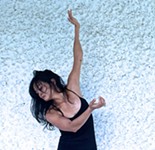Here Today ...
Choreographer Sharon Marroquín lets go through dance in order to live
By Jonelle Seitz, Fri., March 23, 2012
"I'm not afraid of dying," says dancer and choreographer Sharon Marroquín. "We like to think that things are fixed, that situations, especially the good ones, are going to last forever. But when you're hit with something like a cancer diagnosis, you realize that it doesn't last. Nothing lasts; it's just a matter of time. Not the good, not the bad."
The fact of impermanence – perhaps life's overarching rule, yet one so railed against and denied – is the crux of Marroquín's newest and biggest-ever dance project, the full-length The Materiality of Impermanence, a response to her breast cancer diagnosis, treatment, and survival. Her diagnosis in January 2010 was the Mack truck in a collision of loss that involved the death of her father from cancer in July 2009 and the accidental death of her friend and colleague Lucia Rodriguez in August, as well her concurrent divorce, the dissolution of a relationship of 24 years. "I understood, soon after my diagnosis, that in order to not collapse that I needed desperately to let go of what I had wanted my life to be like," says Marroquín. "That I was suddenly on this path that was not the path that I had envisioned."
Though today Marroquín, 44, is rid of the cancer to which she lost a breast and her lymph nodes, the cancer that – either because of her estrogen blocker-medication or her chemotherapy port – was responsible for a blood clot in her neck that required weeks of twice-daily blood-thinning shots and continued blood-thinning medication; the cancer that made medical procedures and medications unimaginable to her previously healthy dancer self her day-to-day reality, she knows it could come back. Or despite the efforts to reduce it, the blood clot, which she says sits in her neck like a little reminder of death's possibility, could dislodge and travel to her lungs or brain.
Context: A Life
Marroquín crafted Materiality during a period of nearly two years, developing, rehearsing, and securing funding for the production in between surgeries, treatments, and taking care of her son, Dalí, now 7 years old, not to mention teaching dance classes and maintaining her day job as a bilingual teacher at a public elementary school. The work, says Marroquín, is not exactly about breast cancer. Rather, the breast cancer experience is a lens through which she explores impermanence, mortality, and attachment. The patterns, vignettes, and movements within, she says, "appeared to me as I was trying to process everything that was happening to me, physically and emotionally and spiritually. So the three parts of who we are are intimately interwoven in the dances."
Marroquín, who danced in her native Mexico, as well as New York and Boston, before landing in Austin in 2000, is as independent in practice as she is in spirit. She has regularly created and staged work for Ballet East and collaborated on projects responding to environmental and global humanitarian issues with Toni Bravo's Diverse Space Dance Theatre. Until Materiality required it, she had no website, no marketing, and virtually no budget for her work. In the manner of a true artist and despite her multiple awards from the Austin Critics Table, recognition doesn't seem to be important to her – although she does want Materiality to be recognized because of its ability to help people. She only began choreographing, she has said, to have work to dance. The jobs that she's taken to make ends meet, in nonprofits and education, are those that value human connection and need over glamour and pay.
In her choreography and performance, Marroquín is strikingly direct and honest. She seems unable to accept cliché, but her movement nevertheless speaks clearly. "I don't ever want to be fake," she has said. In Materiality, she looks at the starkest of universal truths: We're beings doomed to become nonbeings, with our experiences constantly giving way to memories eventually forgotten. For cancer survivors, the reality of impermanence is especially insistent, and its mark on the psyche is indelible. And that's why Marroquín doesn't like to use the phrase "battling cancer," because "it conjures up images of kicking, fighting, and screaming against something that's happening to you. And if you do that, you're going to suffer a lot. And the way to find peace and bliss and joy is to find the way to be OK with death."

And though audience members should be armed with tissues (I've needed them while viewing rehearsals and Marroquín's past work), the peace and joy, Marroquín wants you to know, are not forgotten in this work. "It's not 90 minutes of pain and suffering. There's a lot of joy and light in this journey, also. And I try to bring that forth through the choreography and the dancers."
Acceptance and Creation
When Marroquín, on her lunch break in the teachers' lounge at Widen Elementary, received the phone call that said she had cancer, she was just a few weeks from performing her piece "So Far Ago." In shock, she had to decide whether to cancel the performance – both she and her partner, Frank Yezer, knew that no one else could fill the personal role she'd created with him. She considered delaying her mastectomy until afterward, even though one doctor, she remembers, said, "Nobody is going to tell you to wait." But she did wait. The performances of the dance, for which Marroquín paired herself with septuagenarian and former ballet dancer Yezer, evoked memory and the fleeting quality of youth, and took on special significance. They became, she says, "a kind of good-bye to my body and to my life as it had been." Soon after the last performance, she had back-to-back surgeries and spent the next 14 months in and out of chemotherapy and radiation treatments followed by reconstructive surgeries.
"For the first few months," Marroquín recalls of the period after her diagnosis, "I didn't want to know anything about other people who had experienced the same thing. I didn't want to do research on the Internet. I did not want to talk to any survivors." Though the dance community rallied around her – choreographer Caroline Sutton Clark set up a meal delivery calendar, which came to look like a who's who of Austin dance, as well as a dance-movie fundraiser to help Marroquín with medical expenses – Marroquín had stepped back from choreography. But eventually, she knew that she had to find a way to come to terms with her changed body. Because Todd Wolfson, who had previously photographed her for the Chronicle, "seemed someone who saw things in a different light," Marroquín sent him an email. Soon after, she was looking into his camera lens.
"When I saw the photographs, I was blown away with how beautiful they were. Beautiful in a very nontraditional way, because of the photograph of a woman with only one breast and a big scar across the chest. And yet, in the pictures, I could see in my eyes my own spirit. And as I looked at these photographs, tears were running down my face. I thought to myself, something has to be done with these photographs. They're just going to live on his hard drive? Is that it? That's the end?"
Marroquín's dances generally don't shy away from dark or difficult topics. She's confronted a terrible mining disaster ("Crandall Canyon Mine," 2008), issues of aging and remembrance ("So Far Ago," 2010), the death of her Rodriguez, her colleague ("For You Lucia," 2009), and even her father's journey toward death ("Desprendimiento," 2009). But it wasn't until six months after her diagnosis, after seeing the photographs, that she realized she needed to make a dance about her own illness. In the summer of 2010, "the images started to come."













